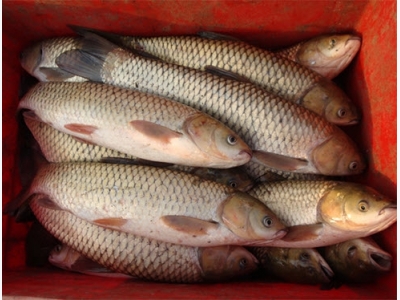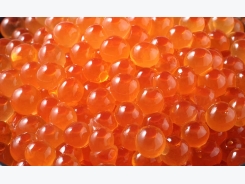Weighing the risks of farming non-native fish species in India

Pangasius, tilapia and carp production increasing
There are about 31 non-native. non-native fish species recorded from aquaculture operations in India. The culture of some species such as pangasius (Pangasianodon hypoththalmus), Nile tilapia (Oreochromis niloticus), red-bellied pacu (Piaractus brachypomus), bighead carp (Aristichtys nobilis), Oncorhynchus mykiss, African catfish (Clarias gariepinus) and others, etc., has only increased during recent years (Table 1). Among these species, pangasius and Nile tilapia were legally introduced during the last few years to supplement fish production. Some of the non-native fishes, such as pangasius and pacu, have been used both for food as well as for ornamental purposes, and hence their possible release into natural habitats was doubled on account of high pressure to propagate them.
The fish diversity of India in aquaculture activities in the country is well represented by the presence of about 120 commercially important fish species, of which 60 species are widely distributed in most of the country’s water bodies. However, there has been intensive aquaculture diversification using non-native fish species. The estimated, annual, average production of non-native species suitable for human consumption amounts to around 20 to 30 percent of the annual average production of marketable fish cultured in India. Many of the cultured, non-native species have been deliberately or inadvertently released and are now present in natural water bodies.
Carps
The total aquacultured fish production of India is estimated at 4.2 million tons, of which non-native carps contributed about 25 percent of this total. Chinese carps – including common carp, grass carp, bighead carp and silver carp – have contributed substantially to commercial aquaculture in India. Among these species, common carp is a fast-growing species cultured in seasonal tanks as the water is retained for only 6-8 months. This provides an inexpensive source of fish protein to rural poor people. Grass carp grow very fast and reach a marketable size of 1-1.5 kg within 8-10 months; these fishes are grown in tanks infested with aquatic weeds, along with other carps. Common carp, grass carp and other non-native carps have become an important food fish for the poor in India.

Fisherman showing well grown grass carp (left). Pond cultured grass carp
Catfishes
Pangas or sutchi catfish (Pangasianodon hypophthalamus) are popular among catfish producers in India. It is the only catfish species that is widely used in commercial aquaculture across the country. In comparison to other aquaculture species, pangas can be stocked at higher densities in ponds under monoculture production. The most important aquaculture attributes of this species are its fast growth, resistance to poor water quality and that it accepts all types of food including animal wastes. Pangas is the major contributor among the catfishes to the aquaculture production in India. Annually over 0.8 million tons of pangas fish are produced in the country.
Although aquaculture of African catfish (C. gariepinus) is banned in India, some aquaculturists have disregarded this and culture it. It is widely believed that the popularity for African catfish aquaculture is due to the simplicity of their rearing, fast growth and acceptability of cheap feed, such as slaughterhouse and chicken waste. The low operational costs and high profits derived from African catfish farming have led to intensification of its production.
Other cultured, non-native fish species
Tilapia farming in India is limited, but wild fish captured from natural waters have increased significantly during the last two years. Culture of Nile tilapia (O. niloticus) – particularly in the states of Andhra Pradesh, Orissa and West Bengal – is now gearing up and the fish is now distributed in many states, particularly the coastal areas. Recently, the government of India has issued certain guidelines for the culture of Nile tilapia.
The introduction of genetically improved tilapia (such as GIFT – Genetically Improved Farmed Tilapia) strains is worth considering. Tilapia significantly tolerate poor water quality conditions and also have disease tolerance under a wide range of environmental conditions. Marketable sizes of 200 to 300 g are reached within four months in subsistence fish-farming systems that typically allow a minimum of two crops per year. In recent years, the popularity of tilapia among consumers has increased in India.

Wild, captured tilapia fish.
Rainbow trout (Oncorhynchus mykiss) has been introduced to Indian cold waters, and has better growth and several suitable traits for culture among coldwater species. The current production of rainbow trout reported from various states is estimated to be about 500 tons annually, but it has the potential to increase many folds in the future in India. Pacu (Piaractus brachypomus) is an unauthorized species but its culture is also increasing in India in recent times in some states particularly in West Bengal and Andhra Pradesh. About 100,000 tons of pacu fish are produced annually in the country.
There is no accurate data available on the culture of non-native species in India because a majority of the species are cultured clandestinely. The culture of all the above mentioned non-native species contributes around 20-30 percent of the aquaculture total in India. Market prices are fluctuating for non-native fish species, and due to lower market prices, these species are considered low-value fish and the consumption of these fish has been increasing locally. Therefore, these non-native species have become important food fish for the poor in India.
Advantages
The culture of non-native fish species has increased rapidly in India over the last decade, especially for pangas, African catfish, common carp, grass carp and silver carp. The livelihoods of a large number of rural poor are associated with the farming and marketing of these non-native species. There has been a steady increase in the production of the fish by small and marginal farmers, who have improved their socioeconomic conditions through farming non-native species. Their culture provides huge contributions to the food supply, livelihood opportunities and poverty alleviation of rural poor.
Potentially adverse effects on local species
In spite of their significant contributions, there is debate over the introduction of non-native species. Any new species introduced to an ecosystem has an impact, although in most cases, the effects may remain unnoticed. Non-native fish species are often considered to pose a threat to biodiversity, and these effects on aquatic biodiversity can result from competition for food and space, habitat destruction, alteration of ecosystems and genetic interaction through hybridization. It is believed that the introduction of farmed non-native species such as African catfish has an adverse impact on small indigenous species in India.
Although non-native species were introduced only for aquaculture in India, they are often found in inland rivers, reservoirs, floodplains, canals and wetlands. In this flood-prone country, non-native species can easily spread from closed culture systems to open water resources during the monsoon season. Scientists have noted that this spread of the fast-growing, non-native fish impacts native ecosystems and threatens native species. Populations of these introduced fish have seen exponential growth and are rapidly extending their range outside the points of introduction.
There is a worrying increase in the number of non-native fish species being detected in rivers, lakes, reservoirs, irrigational tanks and canals in recent years. The non-native fishes moved into open waters inadvertently or due to unawareness or lack of knowledge of the aquaculturists and farmers. The impact of such escapee fishes have been assessed and found to cause ecological problems in several natural aquatic systems. Ecological risks have been mainly caused by non-native species that have become fully established and acclimatized in natural ecosystems and show naturally reproducing populations. In suitable conditions, such species produce abundant populations.
Perspectives
In spite of the potential environmental impacts, there has been only limited evaluation of the effects of non-native species on aquatic flora and fauna in India. So far, none of the studies has addressed the biological interactions among non-native and native species and their potential ecological consequences on each other, as well as local communities and ecosystems. Research on the impacts of the non-native species on biodiversity and ecosystems is therefore urgently needed. Although increased fish production is the key issue for aquaculture in India, sustainable fish farming and best practices must also be considered before further non-native species are introduced to the aquaculture systems of the country.
The issue of non-native species has become one of global importance, particularly as a result of the direct or indirect connection of hydrological systems. The introductions of non-native fish species have been important both in their positive and negative consequences for fishery management, as well as for the native components of the ichthyofauna of natural ecosystems. At present, non-native species are considered one of the major causes of negative effects on the native fish biodiversity in freshwater ecosystems.
At present, aquaculturists prefer non-native species because basic information and culture techniques are available, and it is easy for them to adopt and compete in local and international markets. Over the last two decades, the aquaculture entrepreneurs/farmers have been demanding the importation of many new fish strains and varieties for improved production and competitiveness in the world market. However, environmental, socio-economic and biodiversity issues have been the important considerations for authorities. The National Committee for Introduction of Exotic Aquatic Species in Indian Waters under the Union Ministry of Agriculture, Department of Animal Husbandry, Dairying and Fisheries in New Delhi checks and regulates the importation of non-native fish species in India.
Có thể bạn quan tâm
Phần mềm

Phối trộn thức ăn chăn nuôi

Pha dung dịch thủy canh

Định mức cho tôm ăn

Phối trộn phân bón NPK

Xác định tỷ lệ tôm sống

Chuyển đổi đơn vị phân bón

Xác định công suất sục khí

Chuyển đổi đơn vị tôm

Tính diện tích nhà kính

Tính thể tích ao hồ



 Near-infrared spectrometers determine stage maturity in channel catfish
Near-infrared spectrometers determine stage maturity in channel catfish  Transgenic fish are ready for us — are…
Transgenic fish are ready for us — are…